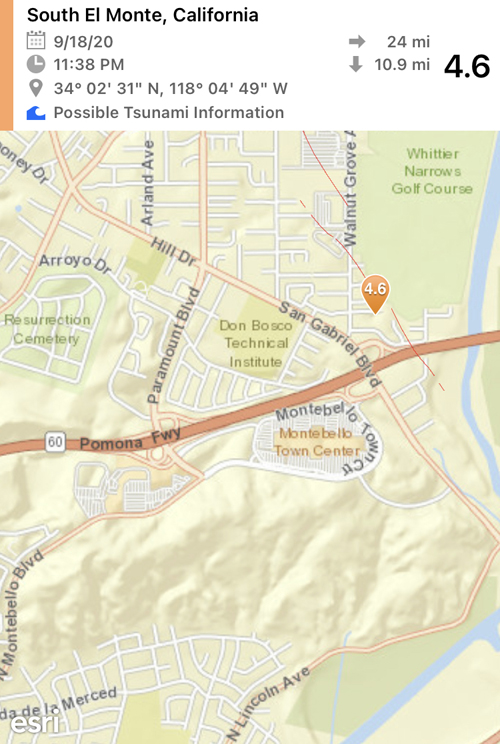
By Charly SHELTON
Last Friday at 11:38 p.m., a M4.5 earthquake struck South El Monte. The shaking was felt across LA in varying degrees of severity, with some residents reporting that they were awakened in their beds by the shaking. At nearly 11 miles deep, the quake was muted by millions of tons of rock that led to only small shakes and anecdotes of waking up in bed rather than massive damage and waking up in the street. Quakes like this, and even smaller ones, can be detected by U.S. Geological Survey equipment and through ShakeAlert residents can get a warning before the shaking starts … depending on where the quake hits.
“Many people got the alert after shaking arrived at their location because they were too close to the epicenter,” said Dr Robert-Michael de Groot, staff scientist with the USGS ShakeAlert Earthquake Early Warning Program. “One thing that’s really important to realize is that this is just the way it goes; I mean, there are lots of faults in in Southern California. If you’re located very close [to a fault when a quake begins], the shaking from the earthquake will make it to you long before the alert actually reaches you. And that’s not a problem with the early warning system. It’s just a fact of physics. It’s just the way it goes. The system has to take time.”
The ShakeAlert system is a new tool that the USGS has in place to warn residents as soon as a quake is detected. The quake data is sent from the equipment back to the hub at USGS. The data is packaged up and the algorithm decides whether or not this quake is strong enough to be felt and whether a ShakeAlert message should be issued. If it warrants an alert, the data pack is sent out to the alert providers – like Google that pushes alerts to Android phones, the City of Los Angeles app ShakeAlertLA, the MyShake app and the QuakeAlert app – that send a notification to phones that shaking may be felt in the app user’s location.
“We’re not talking about tens of seconds for [all of this work by the system]. We’re talking a couple of seconds to make a decision, and that’s pretty darn fast,” de Groot said.
All of this information in just a couple of seconds. Considering it takes the average text message five seconds to fully send from one user to another, this kind of speed to detect, compute, compile and send data packets is incredible. But an earthquake’s S-wave, the wave that causes the shaking feeling, can travel up to five miles a second. So even in the two seconds it takes to process the data and send it out, that is an area of 10 miles around the epicenter that won’t receive the alert until the shaking has started.
“It’s a very small earthquake [at] magnitude 4.5. [For] millions of people in the area (it happened smack in the middle of a very heavily populated region) a lot of people felt it but it’s considered to be a light earthquake so it was over very quickly,” de Groot said. “Smaller earthquakes generally end very quickly. That’s part of the issue. If the earthquake was going on a really long time, if it was a much bigger earthquake, then this would be a very different conversation.”
Despite the brevity of the earthquake, the ShakeAlert system functioned exactly as it was supposed to. Residents who had the app installed or had allowed alerts from Android phones received notifications of the imminent shaking. But the reach can always be wider and the impact more important if more users sign up for alerts. To get the app on your device, search “MyShake,” “QuakeAlert” or “ShakeAlertLA” on the app marketplace of your choice and enable notifications from the app, then allow “Critical Alerts” if prompted.
